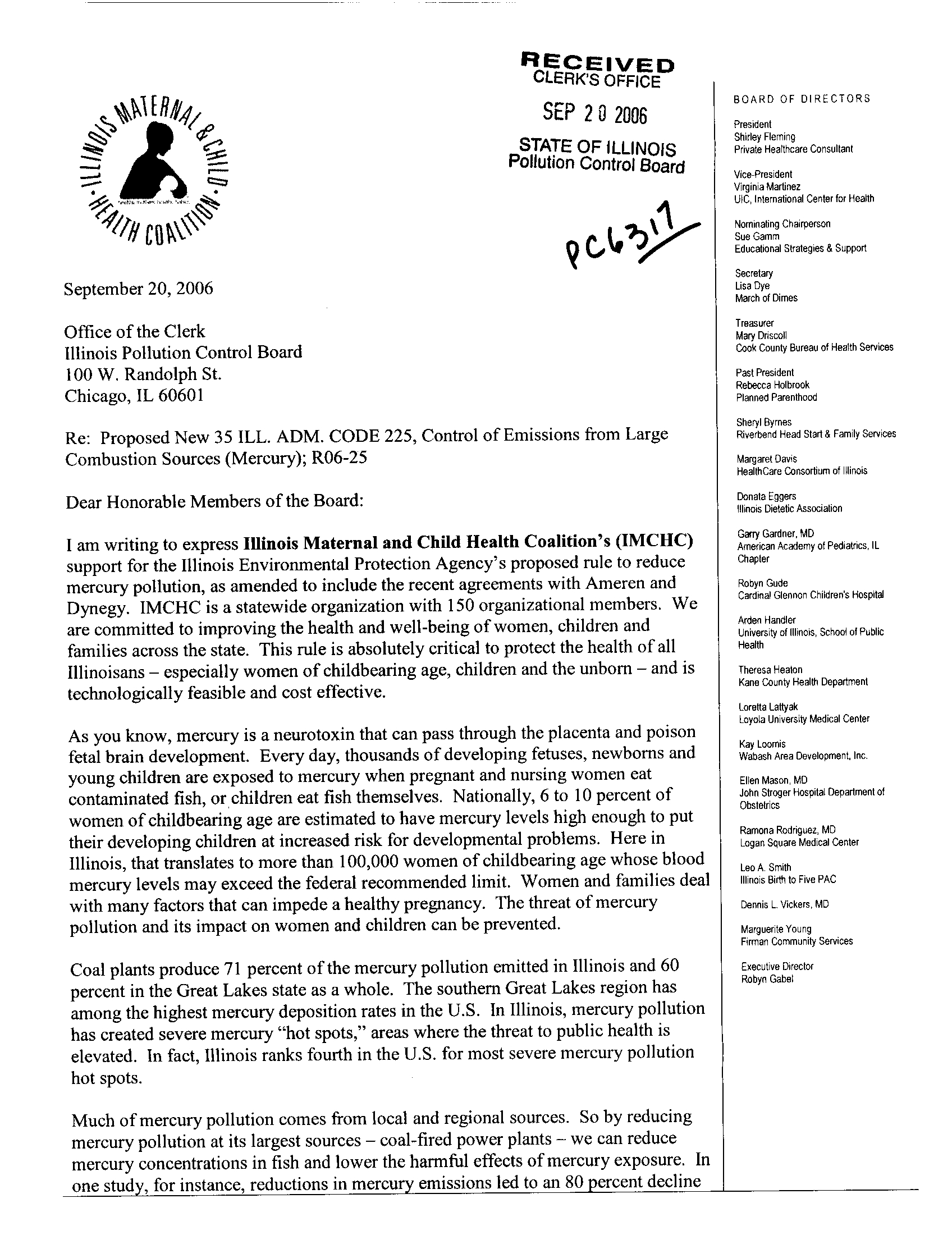September 20, 2006
Office of the Clerk
Illinois Pollution Control Board
100 W. Randolph St
.
Chicago, IL 60601
Re: Proposed New 35 ILL
. ADM
. CODE 225, Control of Emissions from Large
Combustion Sources (Mercury)
; R06-25
Dear Honorable Members of the Board
:
I am writing to express
Illinois Maternal and Child Health Coalition's (IMCHC)
support for the Illinois Environmental Protection Agency's proposed rule to reduce
mercury pollution, as amended to include the recent agreements with Ameren and
Dynegy
. IMCHC is a statewide organization with 150 organizational members
. We
are committed to improving the health and well-being of women, children and
families across the state
. This rule is absolutely critical to protect the health of all
Illinoisans -
especially women of childbearing age, children and the unborn
- and is
technologically feasible and cost effective .
As you know, mercury is a neurotoxin that can pass through the placenta and poison
fetal brain development
. Every day, thousands of developing fetuses, newborns and
young children are exposed to mercury when pregnant and nursing women eat
contaminated fish, or children eat fish themselves
. Nationally, 6 to 10 percent of
women of childbearing age are estimated to have mercury levels high enough to put
their developing children at increased risk for developmental problems
. Here in
Illinois, that translates to more than 100,000 women of childbearing age whose blood
mercury levels may exceed the federal recommended limit
. Women and families deal
with many factors that can impede a healthy pregnancy
. The threat of mercury
pollution and its impact on women and children can be prevented
.
Coal plants produce 71 percent of the mercury pollution emitted in Illinois and 60
percent in the Great Lakes state as a whole
. The southern Great Lakes region has
among the highest mercury deposition rates in the U
.S
. In Illinois, mercury pollution
has created severe mercury "hot spots," areas where the threat to public health is
elevated . In fact, Illinois ranks fourth in the U
.S
. for most severe mercury pollution
hot spots .
Much of mercury pollution comes from local and regional sources
. So by reducing
mercury pollution at its largest sources
- coal-fired power plants
- we can reduce
mercury concentrations in fish and lower the harmful effects of mercury exposure
. In
one study, for instance, reductions in mercury emissions led to an 80 percent decline
RECEIVED
CLERK'S
OFFICE
SEP 2 0 2006
Pollution
STATE OF
Control
ILLINOISBoard
BOARD OF DIRECTORS
President
Shirley Fleming
Private Healthcare Consultant
Vice-President
Virginia Martinez
UIC, International Center for Health
Nominating Chairperson
Sue Gamm
Educational Strategies & Support
Secretary
Lisa Dye
March of Dimes
Treasurer
Mary Driscoll
Cook County Bureau of Health Services
Past President
Rebecca Holbrook
Planned Parenthood
SherylByrnes
Riverbend Head Start & Family Services
Margaret Davis
HealthCare Consortium of Illinois
Donata Eggers
Illinois Dietetic Association
Garry Gardner, MD
American Academy of Pediatrics, IL
Chapter
Robyn Gude
Cardinal Glennon Childrens Hospital
Arden Handler
University of Illinois, School of Public
Health
Theresa Heaton
Kane County Health Department
Loretta Lattyak
Loyola University Medical Center
Kay Loomis
Wabash Area Development, Inc .
Ellen Mason, MD
John Stinger Hospital Department of
Obstetrics
Ramona Rodriguez, MD
Logan Square Medical Center
Leo A . Smith
Illinois Birth to Five PAC
Dennis L
. Vickers, MD
Marguerite Young
Firman Community Services
Executive Director
Robyn Gabel
in mercury contamination levels in nearby fish.
Illinois must take action on mercury pollution because a new federal mercury rule
scheduled to take effect later this fall is simply too little, too late . The federal rule
will perpetuate mercury hot spots like those in Illinois by allowing coal plants to
continue using older technology and purchase the right to continue polluting at high
levels rather than installing equipment to clean up their plants and protect our health
and environment.
Illinois is not alone
. Wisconsin, Massachusetts, Michigan, Minnesota, Ohio, and
Pennsylvania, among others, have initiated mercury reduction proposals similar to the
Illinois rule, showing the rule is reasonable and based on achievable mercury
reduction goals . Affordable, readily available technology already has been shown to
reduce mercury pollution from coal plants by as much as 95 percent . We don't need
additional studies or research . We need to move forward now to protect the health of
our children and future Illinoisans .
A large, diverse coalition of doctors, hospitals, public health officials, children's
advocates, health associations and environmental groups throughout Illinois support
the proposed rule before the IPCB . But what really speaks volumes about this issue is
the fact that Ameren and Dynegy have already agreed to cut mercury pollution from
their power plants by 90 percent in the coming years . It's time to codify their
agreements in law, and to require companies like Midwest Generation that haven't
accepted their corporate responsibility to do the same
.
Sincerely,
Robyn Gabel
Executive Director
1256 W
. CHICAGO AVENUE . CHICAGO, IL 60622 •
TEL'.
.8161.491312
• FAN
: 312
.491
.8171 • EMAIL IImaterna1@111materaLorg WEBSITE: wwW .IImaternaLorg
